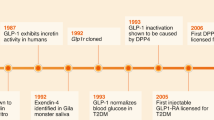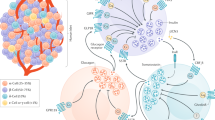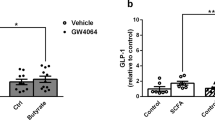Abstract
Diabetes, a disease in which the body does not produce or use insulin properly, is a serious global health problem1,2,3. Gut polypeptides secreted in response to food intake, such as glucagon-like peptide-1 (GLP-1), are potent incretin hormones that enhance the glucose-dependent secretion of insulin from pancreatic beta cells4,5,6. Free fatty acids (FFAs) provide an important energy source and also act as signaling molecules in various cellular processes, including the secretion of gut incretin peptides7,8. Here we show that a G-protein-coupled receptor, GPR120, which is abundantly expressed in intestine, functions as a receptor for unsaturated long-chain FFAs. Furthermore, we show that the stimulation of GPR120 by FFAs promotes the secretion of GLP-1 in vitro and in vivo, and increases circulating insulin. Because GLP-1 is the most potent insulinotropic incretin9,10, our results indicate that GPR120-mediated GLP-1 secretion induced by dietary FFAs is important in the treatment of diabetes.
This is a preview of subscription content, access via your institution
Access options
Subscribe to this journal
Receive 12 print issues and online access
$209.00 per year
only $17.42 per issue
Buy this article
- Purchase on Springer Link
- Instant access to full article PDF
Prices may be subject to local taxes which are calculated during checkout




Similar content being viewed by others
References
Zimmet, P., Alberti, K.G. & Shaw, J. Global and societal implications of the diabetes epidemic. Nature 414, 782–787 (2001).
Gadsby, R. Epidemiology of diabetes. Adv. Drug. Deliv. Rev. 54, 1165–1172 (2002).
Jovanovic, L. & Gondos, B. Type 2 diabetes: the epidemic of the new millennium. Ann. Clin. Lab. Sci. 29, 33–42 (1999).
Creutzfeldt, W. & Ebert, R. New developments in the incretin concept. Diabetologia 28, 565–573 (1985).
Kieffer, T.J. & Habener, J.F. The glucagon-like peptides. Endocr. Rev. 20, 876–913 (1999).
Kreymann, B., Williams, G., Ghatei, M.A. & Bloom, S.R. Glucagon-like peptide-1 7-36: a physiological incretin in man. Lancet 2, 1300–1304 (1987).
Nunez, E.A. Biological complexity is under the 'strange attraction' of non-esterified fatty acids. Prostaglandins. Leukot. Essent. Fatty Acids 57, 107–110 (1997).
Thomsen, C., Storm, H., Holst, J.J. & Hermansen, K. Differential effects of saturated and monounsaturated fats on postprandial lipemia and glucagon-like peptide 1 responses in patients with type 2 diabetes. Am. J. Clin. Nutr. 77, 605–611 (2003).
MacDonald, P.E. et al. The multiple actions of GLP-1 on the process of glucose-stimulated insulin secretion. Diabetes 51 Suppl 3, S434–S442 (2002).
Drucker, D.J. Glucagon-like peptides: regulators of cell proliferation, differentiation, and apoptosis. Mol. Endocrinol. 17, 161–171 (2003).
Fredriksson, R. et al. Seven evolutionarily conserved human rhodopsin G protein-coupled receptors lacking close relatives. FEBS Lett. 554, 381–388 (2003).
Tsao, P., Cao, T. & von Zastrow, M. Role of endocytosis in mediating downregulation of G-protein-coupled receptors. Trends. Pharmacol. Sci. 22, 91–96 (2001).
Ding, G.J., et al. Characterlization and quantitation of NF-κB nuclear translocation induced by interleukin-1 and tumor necrosis factor-α. Development and use of a high capacity fluorescence cytometric system. J. Biol. Chem. 273, 28897–28905 (1998).
Milligan, G., Marshall, F. & Rees, S. G16 as a universal G protein adapter: implications for agonist screening strategies. Trends. Pharmacol. Sci. 17, 235–237 (1996).
Vilsboll, T., et al. Incretin secretion in relation to meal size and body weight in healthy subjects and people with type 1 and type 2 diabetes mellitus. J. Clin. Endocrinol. Metab. 88, 2706–2713. (2003).
Holst, J.J. & Orskov, C. Incretin hormones--an update. Scand. J. Clin. Lab. Invest. Suppl. 234, 75–85 (2001).
Guimbaud, R. et al. Intraduodenal free fatty acids rather than triglycerides are responsible for the release of CCK in humans. Pancreas. 14, 76–82 (1997).
Sidhu, S.S., Thompson, D.G., Warhurst, G., Case, R.M. & Benson, R.S. Fatty acid-induced cholecystokinin secretion and changes in intracellular Ca2+ in two enteroendocrine cell lines, STC-1 and GLUTag. J. Physiol. 528, 165–176 (2000).
Itoh, Y. et al. Free fatty acids regulate insulin secretion from pancreatic beta cells through GPR40. Nature 422, 173–176 (2003).
Cao, X. et al. Aberrant regulation of human intestinal proglucagon gene expression in the NCI-H716 cell line. Endocrinology 144, 2025–2033 (2003).
Reimer, R.A. et al. A human cellular model for studying the regulation of glucagon-like peptide-1 secretion. Endocrinology 142, 4522–4528 (2001).
Trogan, E. et al. Laser capture microdissection analysis of gene expression in macrophages from atherosclerotic lesions of apolipoprotein E-deficient mice. Proc. Natl. Acad. Sci. USA 99, 2234–2239 (2002).
Briscoe, C.P. et al. The orphan G protein-coupled receptor GPR40 is activated by medium and long chain fatty acids. J. Biol. Chem. 278, 11303–11311 (2003).
Brown, A.J. et al. The Orphan G protein-coupled receptors GPR41 and GPR43 are activated by propionate and other short chain carboxylic acids. J. Biol. Chem. 278, 11312–11319 (2003).
Nilsson, N.E., Kotarsky, K., Owman, C. & Olde, B. Identification of a free fatty acid receptor, FFA2R, expressed on leukocytes and activated by short-chain fatty acids. Biochem. Biophys. Res. Commun. 303, 1047–1052 (2003).
Hirasawa, A., et al. Subtype-specific differences in subcellular localization of α1-adrenoceptors: chlorethylclonidine preferentially alkylates the accessible cell surface α1-adrenoceptors irrespective of the subtype. Mol. Pharmacol. 52, 764–770 (1997)
Awaji, T. et al. Real-time optical monitoring of ligand-mediated internalization of alpha1b-adrenoceptor with green fluorescent protein. Mol. Endocrinol. 12, 1099–1111 (1998).
Horie, K., Hirasawa, A. & Tsujimoto, G. The pharmacological profile of cloned and stably expressed alpha 1b-adrenoceptor in CHO cells. Eur. J. Pharmacol. 268, 399–407 (1994).
Awaji, T., Hirasawa, A., Shirakawa, H., Tsujimoto, G., Miyazaki, S. Novel green fluorescent protein-based ratiometric indicators for monitoring pH in defined intracellular microdomains. Biochem. Biophys. Res. Commun. 289, 457–462 (2001).
Gevrey, J.C., Cordier-Bussat, M., Nemoz-Gaillard, E., Chayvialle, J.A. & Abello, J. Co-requirement of cyclic AMP- and calcium-dependent protein kinases for transcriptional activation of cholecystokinin gene by protein hydrolysates. J. Biol. Chem. 277, 22407–22413 (2002).
Acknowledgements
We thank S. Mine, T. Tanaka, Y. Kitagawa and S. Suzuki for their technical assistance. This study was performed through Special Coordination Funds for Promoting Science and Technology from the Ministry of Education, Culture, Sports, Science and Technology, the Japanese Government (G.T.). S.K. and T.A. are supported by the 21st Century Center of Excellence Program “Knowledge Information Infrastructure for Genome Science.”
Author information
Authors and Affiliations
Corresponding author
Ethics declarations
Competing interests
The authors declare no competing financial interests.
Supplementary information
Supplementary Table 1
pEC50s of fatty acids tested on HEK 293 cells stably expressing Gpr120-Gα16 (PDF 19 kb)
Rights and permissions
About this article
Cite this article
Hirasawa, A., Tsumaya, K., Awaji, T. et al. Free fatty acids regulate gut incretin glucagon-like peptide-1 secretion through GPR120. Nat Med 11, 90–94 (2005). https://doi.org/10.1038/nm1168
Received:
Accepted:
Published:
Issue Date:
DOI: https://doi.org/10.1038/nm1168
This article is cited by
-
Oral/taste sensitivity to non-esterified long-chain fatty acids with varying degrees of unsaturation
Food Science and Biotechnology (2024)
-
Association between fatty acids and the risk of impaired glucose tolerance and type 2 diabetes mellitus in American adults: NHANES 2005−2016
Nutrition & Diabetes (2023)
-
Metabolite signaling in the heart
Nature Cardiovascular Research (2023)
-
Liver-derived metabolites as signaling molecules in fatty liver disease
Cellular and Molecular Life Sciences (2023)
-
Omega-3 fatty acids coordinate glucose and lipid metabolism in diabetic patients
Lipids in Health and Disease (2022)



